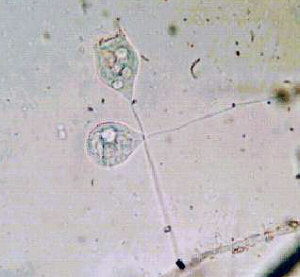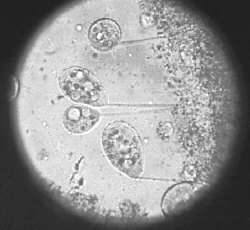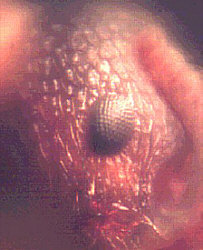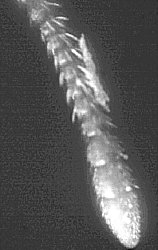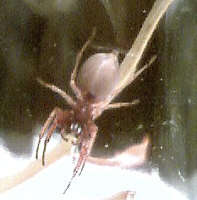Hello! I am from Iowa City and I just wanted to share with you some of the details of my personal set-up for taking digital pictures through the microscope. The equipment is dirt cheap and fairly simple.
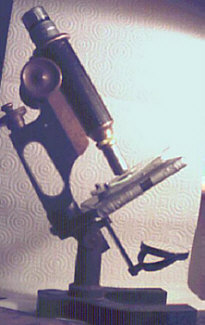
I use a second-hand microscope bought at a yard sale for five dollars, which I have now repaired (shown right). The eyepiece, objective lenses and part of the stage assembly have been cobbled together from parts of other microscopes etc. It had been clearly neglected but once it was cleaned and oiled, the mechanics - especially the coarse and fine focus, proved to be one of the best I have encountered. It's a pity it didn't come with its original lenses but it works like a charm and I can even make out individual bacteria cells with it. (By the way, can anyone identify when this particular instrument by Bausch and Lomb was made? I sure would like to know.)
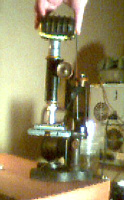 For the microscope
camera I use a 'JamC@m 2' made by KBGear Inc. which
is a digital stills camera providing up to 640 x 480
resolution (shown in use right). It costs about $80 -
$100 depending on source. The camera is fixed focus
(focusing from about one foot to infinity) and is simply held
over the microscope eyepiece by hand. The lens mount is
recessed slightly into the camera casing which fits over the
smaller eyepiece quite easily. It doesn't even have a flash
and is similar to those disposable film cameras in usage i.e.
just point and shoot. The entire set-up
- microscope plus camera and the assortment of lenses
etc. used to restore the microscope cost me about
$100. It's interesting to compare this to the IntelPlay QX3 toy video microscope which sells at a
similar price.
For the microscope
camera I use a 'JamC@m 2' made by KBGear Inc. which
is a digital stills camera providing up to 640 x 480
resolution (shown in use right). It costs about $80 -
$100 depending on source. The camera is fixed focus
(focusing from about one foot to infinity) and is simply held
over the microscope eyepiece by hand. The lens mount is
recessed slightly into the camera casing which fits over the
smaller eyepiece quite easily. It doesn't even have a flash
and is similar to those disposable film cameras in usage i.e.
just point and shoot. The entire set-up
- microscope plus camera and the assortment of lenses
etc. used to restore the microscope cost me about
$100. It's interesting to compare this to the IntelPlay QX3 toy video microscope which sells at a
similar price.
Unfortunately I only have two cameras available to me: a 'Webcam 2' (Creative Labs Inc.) which was used to take the photo' of my 'scope and camera, and the 'Jamcam 2' used to take the photo's through the microscope. The webcam only has a resolution of 320 x 240 pixels so the image above is the best achievable.
Pictures taken with
the microscope set-up are a bit on the blurry side, but I
have improved the results using the sharpening filter in
'Paint Shop Pro'. Also the color balance is off but that
appears to be a result of the low light used i.e. an ordinary
desk lamp. The microscope has no iris diaphragm or
condenser to adjust the lighting, but you can still make out
many of the details in subjects like pond
life. Even the thin hair-like stalks of the bell
animal (Vorticella?) shown below when photographed
alive are visible.
|
|
When using the 'JamC@m 2' over the microscope I first focus
the microscope by eye then place the camera over it, steady
the camera by hand and press the shutter button. Its very
simple - no special stands, camera mounts etc. used. It is
slightly tricky to line up the camera and on average I mess
up one shot out of eight.
I use an IBM model 750 computer with a P-90 processor for image processing, which of course is very outdated but still very adequate ... and thats it!
Comments to the author David Young welcomed.
Image gallery by the author.
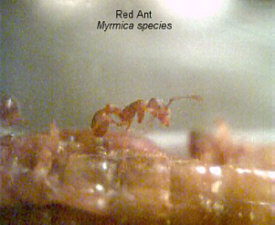 Here
is a selection of ant pictures. I keep ants as a
hobby and have a colony of red ants (Myrmica
species) which I am raising from queens collected
last year. I also have a colony of Aphaenogaster
species. These photos were taken using only a
'Webcam 2' without additional lenses. For the
really close-up shots I removed a plastic focus knob
which prevented focusing closer than five
centimeters. Here
is a selection of ant pictures. I keep ants as a
hobby and have a colony of red ants (Myrmica
species) which I am raising from queens collected
last year. I also have a colony of Aphaenogaster
species. These photos were taken using only a
'Webcam 2' without additional lenses. For the
really close-up shots I removed a plastic focus knob
which prevented focusing closer than five
centimeters. |
|
|
Image right, a sack spider. |
|
